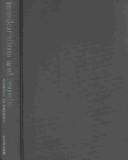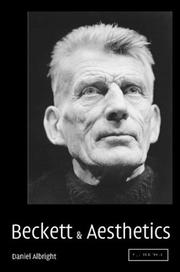| Listing 1 - 10 of 30 | << page >> |
Sort by
|

ISBN: 052157305X Year: 1997 Publisher: Cambridge New York Melbourne Cambridge University Press
Abstract | Keywords | Export | Availability | Bookmark
 Loading...
Loading...Choose an application
- Reference Manager
- EndNote
- RefWorks (Direct export to RefWorks)
Poetry --- Pound, Ezra --- Yeats, William B. --- Eliot, T.S. --- Poetics --- Poétique --- Poëtica --- Science in literature --- Sciences dans la littérature --- Wetenschappen in de literatuur --- American poetry --- -Literature and science --- -Modernism (Literature) --- -Poetics --- Poetry and science --- Science and literature --- Science and poetry --- Science and the humanities --- American literature --- History and criticism --- History --- -History --- -Technique --- Eliot, T. S. --- -Pound, Ezra --- -Yeats, W. B. --- -Knowledge --- -Science --- Knowledge --- -Eliot, T. S. --- Literature and science --- Modernism (Literature) --- Technique --- Pound, Ezra, --- Yeats, W. B. --- D. E. D. I., --- Daemon Est Deus Inversus, --- Ganconagh, --- I., D. E. D., --- Ĭeĭts, U. B. --- Ĭeĭts, Uilʹi︠a︡m Batler, --- Weilian Batele Yezhi, --- Yeats, William Butler, --- Yeṭs, Ṿilyam Baṭler, --- יטס, יטלאם בטלר --- ייטס, ויליאם בטלר, --- 威廉,巴特勒,叶芝, --- Pound, Ezra Loomis, --- Atheling, William, --- Bawnd, Izrā, --- Paount, Ezra, --- Pʻaundŭ, Ejŭra, --- Pavnd, Ezra, --- E. P. --- P., E. --- T. J. V., --- V., T. J., --- Pangde, --- Poet of Titchfield Street, --- Ai-lüeh-tʻe, --- Eliot, Thomas Stearns, --- Īliyūt, T. S., --- Elliŏtʻŭ, --- Eliot, Thōmas S., --- Eliot, Th. S., --- Eliot, Thomas Stern, --- Elyoṭ, T. S., --- Ėliot, Tomas Stirns, --- אליוט ט.ס --- אליוט, ת. ס. --- Science. --- Eliot, Thomas Stearns --- 20th century --- United States --- Ireland --- Literature and science - Ireland - History - 20th century. --- Йейтс, У. Б. --- Йейтс, Уильям Батлер, --- Yeats, William Butler --- Pound, Ezra Loomis --- Atheling, William --- Bawnd, Izrā --- Paount, Ezra --- Pʻaundŭ, Ejŭra --- Pavnd, Ezra --- T. J. V. --- V., T. J. --- Pangde --- Poet of Titchfield Street

ISBN: 0226012662 0226012670 Year: 2004 Publisher: Chicago, Ill. University of Chicago Press
Abstract | Keywords | Export | Availability | Bookmark
 Loading...
Loading...Choose an application
- Reference Manager
- EndNote
- RefWorks (Direct export to RefWorks)
Music --- anno 1900-1999 --- Modernism (Music) --- History and criticism. --- Modernism (Music). --- Modernism (Art) --- Art and music

ISBN: 019212188X 9780192121882 Year: 1972 Publisher: London: Oxford university press,
Abstract | Keywords | Export | Availability | Bookmark
 Loading...
Loading...Choose an application
- Reference Manager
- EndNote
- RefWorks (Direct export to RefWorks)
English literature --- Thematology --- Yeats, William B. --- Myth in literature --- Yeats, W B --- Criticism and interpretation --- Ireland --- In literature --- Myth in literature. --- Yeats, William Butler, --- Yeats, W. B. --- Critique et interprétation --- Criticism and interpretation. --- In literature. --- Yeats, William Butler --- Yeats, W. B. - (William Butler), - 1865-1939 - Criticism and interpretation --- Ireland - In literature --- Critique et interprétation. --- Yeats, W. B. - (William Butler), - 1865-1939 --- Critique et interprétation.

ISBN: 0521829089 Year: 2003 Publisher: Cambridge New York Port Melbourne Cambridge University Press
Abstract | Keywords | Export | Availability | Bookmark
 Loading...
Loading...Choose an application
- Reference Manager
- EndNote
- RefWorks (Direct export to RefWorks)
Book
ISBN: 0226012492 9780226012490 Year: 1978 Publisher: Chicago: University of Chicago press,
Abstract | Keywords | Export | Availability | Bookmark
 Loading...
Loading...Choose an application
- Reference Manager
- EndNote
- RefWorks (Direct export to RefWorks)
Psychology and literature --- Identity (Psychology) in literature --- Lawrence, D. H. --- Woolf, Virginia, --- Mann, Thomas, --- Characters --- Identity (Psychology) in literature. --- Personality in literature. --- Psychological fiction, English --- Psychological fiction, German --- History and criticism. --- Knowledge --- Psychology. --- Lawrence, D. H., --- Lawrence, David Herbert, --- Lawrence, David Herbert, - 1885-1930 - Characters --- Woolf, Virginia, - 1882-1941 - Characters --- Mann, Thomas, - 1875-1955 - Characters --- Lawrence, David Herbert, - 1885-1930 --- Woolf, Virginia, - 1882-1941 --- Mann, Thomas, - 1875-1955

ISBN: 0226012549 0226012530 9780226012544 Year: 2000 Publisher: Chicago, IL : University of Chicago Press,
Abstract | Keywords | Export | Availability | Bookmark
 Loading...
Loading...Choose an application
- Reference Manager
- EndNote
- RefWorks (Direct export to RefWorks)
From its dissonant musics to its surrealist spectacles (the urinal is a violin!), Modernist art often seems to give more frustration than pleasure to its audience. In Untwisting the Serpent, Daniel Albright shows that this perception arises partly because we usually consider each art form in isolation, even though many of the most important artistic experiments of the Modernists were collaborations involving several media—Igor Stravinsky’s The Rite of Spring is a ballet, Gertrude Stein’s Four Saints in Three Acts is an opera, and Pablo Picasso turned his cubist paintings into costumes for Parade.Focusing on collaborations with a musical component, Albright views these works as either figures of dissonance that try to retain the distinctness of their various media (e.g. Guillaume Apollinaire’s Les Mamelles de Tirésias) or figures of consonance that try to lose themselves in some total effect (e.g. Arnold Schoenberg’s Erwartung). In so doing he offers a fresh picture of Modernism, and provides a compelling model for the analysis of all artistic collaborations.
Art and music. --- Modernism (Art) --- Modernism (Literature) --- Modernism (Music) --- Music and literature. --- Music --- Philosophy and aesthetics. --- Modernism (Art). --- Modernism (Literature). --- Modernism (Music). --- Music and literature --- Philosophy and aesthetics
Book
ISBN: 9781441179098 Year: 2012 Publisher: London New York : Continuum,
Abstract | Keywords | Export | Availability | Bookmark
 Loading...
Loading...Choose an application
- Reference Manager
- EndNote
- RefWorks (Direct export to RefWorks)
Shakespeare, William, --- Berlioz, Hector, --- Verdi, Giuseppe, --- Wagner, Richard, --- Britten, Benjamin, --- Berlioz, Hector --- Wagner, Richard --- Verdi, Giuseppe --- Britten, Benjamin
Book
ISBN: 9781421416441 9781421416434 1421416433 1421416441 Year: 2015 Publisher: Baltimore, Md Johns Hopkins University Press
Abstract | Keywords | Export | Availability | Bookmark
 Loading...
Loading...Choose an application
- Reference Manager
- EndNote
- RefWorks (Direct export to RefWorks)
How do you rationally connect the diverse literature, music, and painting of an age? Throughout the modernist era-which began roughly in 1872 with the Franco-Prussian War, climaxed with the Great War, and ended with a third catastrophe, the Great Depression-there was a special belligerence to this question. It was a cultural period that envisioned many different models of itself: to the Cubists, it looked like a vast jigsaw puzzle; to the Expressionists, it resembled a convulsive body; to the Dadaists, it brought to mind a heap of junk following an explosion. In Putting Modernism Together, Daniel Albright searches for the center of the modernist movement by assessing these various artistic models, exploring how they generated a stunning range of creative work that was nonetheless wound together aesthetically, and sorting out the cultural assumptions that made each philosophical system attractive. Emerging from Albright's lectures for a popular Harvard University course of the same name, the book investigates different methodologies for comparing the evolution and congruence of artistic movements by studying simultaneous developments that occurred during particularly key modernist years. What does it mean, Albright asks, that Joseph Conrad's Heart of Darkness, published in 1899, appeared at the same time as Claude Debussy's Nocturnes-beyond the fact that the word "Impressionist" has been used to describe each work? Why, in 1912, did the composer Arnold Schoenberg and the painter Vassily Kandinsky feel such striking artistic kinship? And how can we make sense of a movement, fragmented by isms, that looked for value in all sorts of under- or ill-valued places, including evil (Baudelaire), dung heaps (Chekhov), noise (Russolo), obscenity (Lawrence), and triviality (Satie)?Throughout Putting Modernism Together, Albright argues that human culture can best be understood as a growth-pattern or ramifying of artistic, intellectual, and political action. Going beyond merely explaining how the artists in these genres achieved their peculiar effects, he presents challenging new analyses of telling craft details which help students and scholars come to know more fully this bold age of aesthetic extremism.
Modernism (Literature) --- Modernism (Music) --- Modernism (Art) --- Music and literature --- Art and music --- Music and art --- Music --- Literature and music --- Literature --- Art, Modernist --- Modern art --- Modernism in art --- Modernist art --- Aesthetic movement (Art) --- Art, Modern --- Modernism in music --- Modernist music --- Musical modernism --- Style, Musical --- Crepuscolarismo --- Literary movements --- Music and literature. --- Art and music. --- Art styles --- Painting --- music [performing arts genre] --- painting [image-making] --- literary studies --- Modernist --- anno 1800-1999
Book
ISBN: 0300187645 9780300187649 1306475031 9781306475037 9780300186628 0300186622 Year: 2014 Publisher: New Haven Yale University Press
Abstract | Keywords | Export | Availability | Bookmark
 Loading...
Loading...Choose an application
- Reference Manager
- EndNote
- RefWorks (Direct export to RefWorks)
While comparative literature is a well-recognized field of study, the notion of comparative arts remains unfamiliar to many. In this fascinating book, Daniel Albright addresses the fundamental question of comparative arts: Are there many different arts, or is there one art which takes different forms? He considers various artistic media, especially literature, music, and painting, to discover which aspects of each medium are unique and which can be translated from one to another. Can a poem turn into a symphony, or a symphony into a painting? Albright explores how different media interact, as in a drama, when speech, stage décor, and music are co-present, or in a musical composition that employs the collage method of the visual arts. Tracing arguments and questions about the relations among the arts from Aristotle Æsá Poetics to the present day, he illuminates the understudied discipline of comparative arts and urges new attention to its riches.
Arts. --- Arts, Fine --- Arts, Occidental --- Arts, Western --- Fine arts --- Humanities --- Arts, Primitive
Book
ISBN: 1472557476 1472554841 1280578440 9786613608192 1441124071 9781441124074 9781280578441 9781441179098 1441179097 9781472557476 9781472554840 661360819X Year: 2012 Publisher: London ; New York : Continuum,
Abstract | Keywords | Export | Availability | Bookmark
 Loading...
Loading...Choose an application
- Reference Manager
- EndNote
- RefWorks (Direct export to RefWorks)
Great Shakespeareans offers a systematic account of those figures who have had the greatest influence on the interpretation, understanding and cultural reception of Shakespeare, both nationally and internationally. In this volume, leading scholars assess the contribution of Berlioz, Verdi, Wagner and Britten to the afterlife and reception of Shakespeare and his plays. Each substantial contribution assesses the double impact of Shakespeare on the figure covered and of the figure on the understanding, interpretation and appreciation of Shakespeare, provide a sketch of their subjects intellectual
Music and literature. --- Literature and music --- Literature --- Berlioz, Hector, --- Britten, Benjamin, --- Shakespeare, William, --- Verdi, Giuseppe, --- Wagner, Richard, --- Wagner, Wilhelm Richard, --- Drach, Wilhelm, --- Fājner, Rītshārd, --- Vāgners, Richards, --- Vagner, Rikhard, --- Vagner, R. --- Wagner, R. --- Wagunā, R., --- Vagneri, Rihard, --- Wagner, Riccardo, --- ואגנר, ריכארד, --- ואגנר, ריכרד, --- Verdi, Dzhuzepe, --- Verdi, Fortunino Giuseppe Francesco, --- Verdis, Dž., --- Verdi, G. --- Verudi, G., --- Wei'erdi, --- ליאונקובלו, ר. --- רדדי, ג. --- ڤيردي، جيوسپي، --- Verdi, József, --- Verdi, Jakab, --- Verdi, Joseph, --- Verdi, Giuseppo, --- Verdi, D., --- Verdi, Dzh., --- Shakespeare, William --- Shakespear, William, --- Shakspeare, William, --- Šekʻspiri, Uiliam, --- Saixpēr, Gouilliam, --- Shakspere, William, --- Shikisbīr, Wilyam, --- Szekspir, Wiliam, --- Šekspyras, --- Shekspir, Vilʹi︠a︡m, --- Šekspir, Viljem, --- Tsikinya-chaka, --- Sha-shih-pi-ya, --- Shashibiya, --- Sheḳspir, Ṿilyam, --- Shaḳspir, Ṿilyam, --- Syeiksŭpʻio, --- Shekspir, V. --- Szekspir, William, --- Shakespeare, Guglielmo, --- Shake-speare, William, --- Sha-ō, --- Şekspir, --- Shekspir, Uiliam, --- Shekspir, U. --- Šekspir, Vilijam, --- Ṣēkspiyar, Viliyam, --- Shakspir, --- Shekspyr, Vyli︠e︡m, --- Şekspir, Velyam, --- Ṣēkspiyar, Villiyam, --- Shēkʻspʻiyr, Vlilliam, --- Ṣēkspiyar, --- Ṣēkspiyar Mahākavi, --- Ṣēkspiyar Mahākaviya, --- Sheḳspier, Ṿilyam, --- Shēkʻspir, --- Shakespeare, --- Śeksper, --- Шекспир, Вильям, --- Шекспир, Уильям, --- שייקספיר, וויליאם, --- שייקספיר, וו., --- שיקספיר, וויליאם --- שיקספיר, ויליאם --- שיקספיר, ויליאם, --- שכספיר, ויליאם, --- שכספיר, וילים, --- שכספיר, ו׳ --- שעפקספיר, וויליאם, --- שעקספיער, וויליאם --- שעקספיער, וויליאם, --- שעקספיער, ווילליאם --- שעקספיער, וו., --- שעקספיר --- שעקספיר, וו --- שעקספיר, וויליאם, --- שעקספיר, וויליאמ --- שעקספיר, ווילליאם --- שעקספיר, ווילליאם, --- שעקספיר, וו., --- שעקספיר, װיליאם, --- שעקספיר, װילליאם, --- שעקספיר, װ., --- שעקספער --- שעקספער, וויליאמ --- שקספיר --- שקספיר, וו --- שקספיר, וויליאם --- שקספיר, וויליאם, --- שקספיר, ווילים, --- שקספיר, וילאם --- שקספיר, ויליאם --- שקספיר, ויליאם, --- שקספיר, ויליים, --- שקספיר, וילים --- שקספיר, וילים, --- شاكسبير، وليم --- شاكسپير، وليم --- شكسبير، وليام --- شكسبير، وليم --- شكسبير، وليم، --- شكسبير، و. --- شكسپير، وليم --- شكسپير، ويليام --- شيكسبير، وليام --- شيكسبير، وليام.، --- شيكسبير، وليم --- شکسبير، وليم --- وليم شکسبير --- 沙士北亞威廉姆, --- 沙士比亞威廉姆, --- 莎士比亞威廉姆, --- 莎士比亞威廉, --- 莎士比亞, --- Berlioz, Gektor, --- Berlioz, Khektor, --- Berlioz, Louis Hector, --- Berlioz, H. --- Criticism and interpretation. --- Appreciation. --- Berlioz, --- Verdi, Giuseppe --- Verdi, Dzhuzepe --- Verdi, Fortunino Giuseppe Francesco --- Verdis, Dž. --- Verudi, G. --- Wei'erdi --- Verdi, József --- Verdi, Jakab --- Verdi, Joseph --- Verdi, Giuseppo --- Verdi, D. --- Verdi, Dzh. --- Britten, Edward Benjamin --- Britten, Benjamin --- Britten, Benjamin E.
| Listing 1 - 10 of 30 | << page >> |
Sort by
|

 Search
Search Feedback
Feedback About UniCat
About UniCat  Help
Help News
News